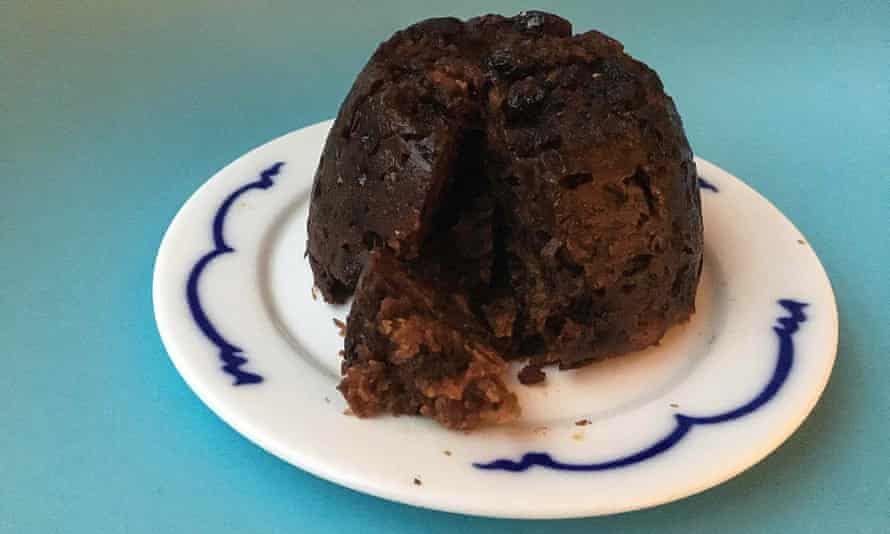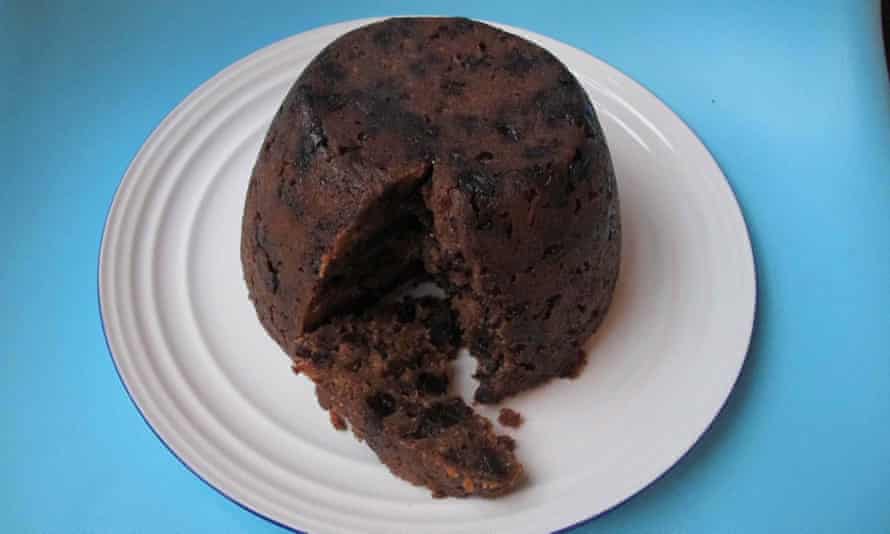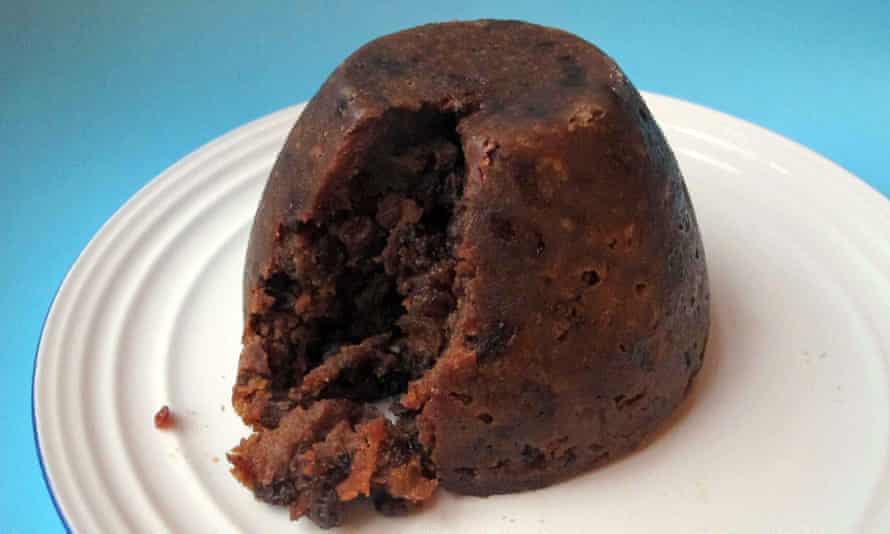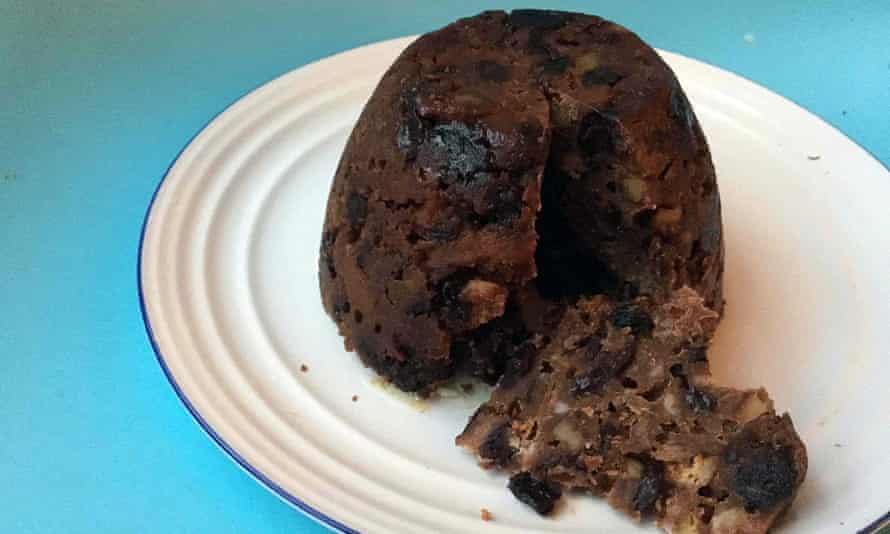How Long To Cook A 1lb Christmas Pudding
T hough it's not fashionable to admit it in this age of chocolate tortilla-covered chips and salted caramel bombes, I bloody love Christmas pudding. However many pigs in blankets have been put away beforehand, no matter the number of chocolates scoffed in place of breakfast, I solemnly swear I'll never ever give in to the inevitable suggestion that we save it until Boxing Day instead. Partly because Boxing Day is for trifle, and I'm not missing out on that, but mostly because it doesn't matter how full I am, there's always room for a little wedge of fruity stodge on top of the mound of other food.
And though it may seem rather early to be thinking of Christmas, we're only days away from what's traditionally known as "Stir-up Sunday", thanks to the opening words from the Book of Common Prayer's collect for the Sunday before Advent, "Stir up, we beseech thee, O Lord, the wills of thy faithful people" – an unambiguous signal to dig out the silver sixpence and get mixing. Real pudding aficionados may have made them months ago, but, with more than a month to go before the big day, there's still ample time to wield the wooden spoon.
The carbs

Christmas puddings are as much about texture as flavour – they should be unapologetically dense, without being solid. Mary Berry makes hers with a standard cake base, creaming together butter and sugar before adding eggs and flour, giving a lighter, fluffier result which, although delicious, doesn't seem quite in the spirit of the dish.
Traditionally, such puddings are made from breadcrumbs and, often, flour; Richard Boston, author of this very newspaper's first beer column, supplies a flour-free version, which may be to blame for his pudding's soft, slightly oily consistency – the flour clearly does a better job of soaking up the melted suet than mere breadcrumbs alone. Gary Rhodes includes ground almonds in the recipe in Rhodes Around Britain, but I'd prefer to keep the batter fairly plain and allow the fruit to do the talking instead.
Raymond Blanc suggests using brown rather than white breadcrumbs; once everything is mixed together, the difference is fairly negligible, but still, a couple of testers claim to be able to detect a slightly maltier note, which is enough for me to recommend them, though whatever needs using up should do the job.
Berry uses self-raising flour, and Nigella Lawson and Rhodes add baking powder to their puddings. Older recipes employ no raising agents, but tastes change, and a slightly lighter consistency should be welcome at this point in proceedings.
The liquid

Everyone uses eggs in their puddings, but Boston and the recipe from Florence White's Good Things in England, reputedly from the court of George I (though historian Ivan Day casts doubt on its provenance), also add milk, resulting in a slightly squidgier texture we all rather like.
Boston and Rhodes's stout also finds favour for the rich, almost savoury character it gives the pudding – less stridently alcoholic than Berry's rum or White's brandy, but a good match with the dark sugars and dried fruit. That said, we also prove suckers for Lawson's fruit soaked in "sweet, dark, sticky sherry that has a hint of liquorice, fig and treacle about it" – doing it this way, rather than simply adding the booze to the mix and hoping for the best, means more flavour seems to find its way into the finished pudding. If you're not a sherry fan, other sticky sweet alcohols would probably work, too, though I would respectfully suggest that madeira or tawny port might be a better bet than, say, Jägermeister.
The fruit

The backbone, indeed the whole skeleton of a Christmas pudding, which should be cram-full of the stuff – the plums originally referred to raisins, but that's no reason to reject the juicy prunes deployed by Lawson and Rhodes, though I slightly prefer the sweeter, crunchier dried fig in combination with sweet little currants and juicy sultanas. Feel free to make up the weight with whatever you happen to have on hand, however; Berry uses dried apricots, for example.
Rhodes and Lawson both add grated apple to their puddings, with Rhodes chucking in a carrot for good measure, a combination also recommended in the 1922 recipe collected in Mary Gwynn's WI Cookbook. I want to like this more than I do; the fresh stuff gives Rhodes's pudding an almost mushy consistency, and testers agree they would prefer a bit more body. Eat more veg with your turkey instead.
Mixed peel is a must for me, because I love it, though if you're able to find the candied citron called for by White, you're a better person than me (as I discover too late, it is, inevitably, available online). I'm also a big fan of Berry's blanched almonds, which add textural interest to a dessert that can sometimes feel a bit like it's aimed at those who have mislaid their false teeth while napping during the Queen's speech.
Sugar
Though all that fruit provides a hefty hit of sugar, a little more is welcome – it is Christmas, after all. Testers find Rhodes's and Lawson's dark muscovado a little too bitter for their liking, preferring the toffeeish sweetness of Boston and Berry's light variety, though I will be sneaking in a little of Rhodes's treacle, too, because it goes so well with the stout. Golden syrup or honey can be used instead if you're not a fan.
Fat

Steamed puddings are one of the few excuses we have to break out the suet, although for once, I'd steer clear of the fresh kind, which gives White's 18th-century recipe an almost greasy texture … and a distinct whiff of the chippie. Berry goes for butter, which, cold and grated, is a decent vegetarian substitute, though its lower melting point means puddings using it will have a denser texture than those made with suet – or, of course, you could brave vegetarian suet, if you can work out which contain non-hydrogenated vegetable oils from sustainable sources.
Flavourings
I'm going to keep things trad with the mixed spice everyone but Lawson deploys (she prefers cinnamon and cloves) and a little of Rhodes's and Berry's grated orange and lemon zest to add a citrussy freshness to the dish, though I shall not be using Boston's and Rhodes's lemon juice, because I don't think Christmas pudding ought to be at all sour. If you taste the mix and disagree, however, feel free to add it to taste.
Storing and cooking
Rhodes suggests resting the mixture for up to a week before steaming, and, if you have the luxury of time, this will no doubt help the flavours develop even further. More important is to give it a long initial steam to caramelise the sugars – White suggests as much as eight hours, though I think Rhodes' four hours is sufficient to cook them through.
The perfect Christmas pudding

Makes 1 x 1.4l/2½ pint pudding
400g dried fruit of your choice (I like 150g currants, 150g sultanas, 100g dried figs, roughly chopped)
50g candied peel
175ml pedro ximénez sherry
150g soft light brown sugar
1/2 tsp mixed spice
75g self-raising flour
Pinch of salt
75g fresh breadcrumbs, preferably brown
Finely grated zest of 1 unwaxed lemon and 1 unwaxed orange
150g suet
50g blanched almonds, roughly chopped
1 egg, beaten
1 tbsp treacle
150ml stout
75ml milk
Soak the dried fruit and peel in the sherry overnight.
Whisk together the sugar, spice, flour, salt and breadcrumbs in a large mixing bowl then stir in the zest, suet and almonds. Beat together the egg and treacle then mix into the dry ingredients along with the stout and milk – stirring should traditionally be shared by everyone in the household, stirring from east to west, while making a wish. Stir in the fruit and any sherry in the bottom of the bowl, and then taste the mixture and add a little more mixed spice or sherry if you like, and any silver coins, rings or other charms you might like to break your family's teeth on.
Thoroughly grease a 1.4l/2½ pint pudding basin, including the lid, and spoon the mixture in – it should be no more than three-quarters full. Cut a round of greaseproof paper to fit the top, then cover with a lid, or two pieces of pleated foil. Wrap the whole lot in foil to ensure it is watertight. Steam in a steamer – or a saucepan with a saucer, or the lid of a jar, in the bottom – for 4 hours, checking the water level regularly. Store in a cool place until Christmas Day, feeding occasionally with alcohol if you like your puddings boozy.
Steam for 1.5 hours then top with booze, light and serve with brandy butter, custard or (my favourite) ice-cream.
Am I alone in my wholehearted love of Christmas pudding, or does anyone else relish a slab of fruity stodge on the big day? And if you're not a fan, what do you round off the meal with?
How Long To Cook A 1lb Christmas Pudding
Source: https://www.theguardian.com/lifeandstyle/wordofmouth/2016/nov/17/how-to-cook-the-perfect-christmas-pudding
Posted by: desimonedoothis.blogspot.com

0 Response to "How Long To Cook A 1lb Christmas Pudding"
Post a Comment